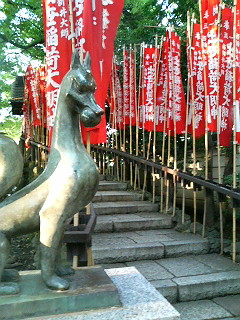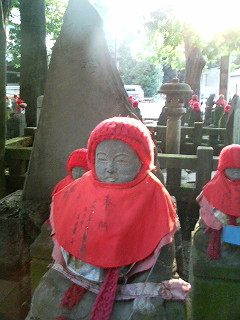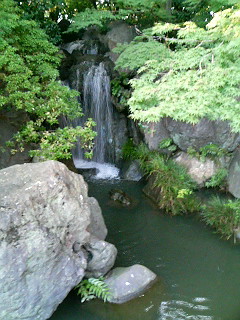   |
|||
 |
|||
|
n i s h i ... a r a i  The miraculous creative waters of nishiarai ---- I discovered this grand temple complex in 2003, after getting lost while walking around Tokyo. It is quite out of the way, located as it is in the Adachi Ward, north of the city center. After hours of walking around and stressing about where in the world I was, I eventually reached the Kan-Nana Dori (Number Seven Ring Road), which promptly led me to this large and alluring temple. It is called Nishi Arai Taishi, or Gochisan Henshouin Soujiji. It was founded by Koubou Daishi Kuukai in 826. Yes, you read that right -- 826AD. That makes this place nearly 1200 years old. The name Nishiarai came from the well (or water fountain) located in the area of the temple. When Kuukai prayed, water suddenly came from the well. Hence the name, Nishi Ara I (Western New Well). It is funny that upon my second visit to the temple in 2006, I was very taken by the appearance of the waterfall at the back of the temple (see the bottom photo on the left.) I didn't know anything about the history of this temple, but as I stood looking at the water gushing from the rock, I had the feeling that it had miraculously arisen, miraculously spurted up from the innards of the earth. For a moment, on that hot August afternoon, I shared in Kuukai's primeval wonder: here was creation at work, here was the mystery of manifestation. Since I had been absorbed all day about how to learn the secrets of manifestation, I realized in retrospect, that my visit to Nishiarai Taishi had been a pilgrimage. I hope to make the pilgrimage again sometime soon. During the Muromachi period and into the Sengoku period, the Chiba clan held control of the region (that explains why the nearby Chiba Prefecture has the name that it does.) Concerning the surrounding Adachi Ward and adjacent Arakawa Ward: the Great Senju Bridge was built in 1594. In the Edo Period, parts were under the direct control of the Tokugawa shogunate, and parts were under the administration of Kan'ei-ji, a temple in present-day Ueno, Tokyo. ĄB ĄŹĄĀĄÄĄáĄÖ Ą^ĄtĄÄ ĄáĄāĄpĄ} ĄĀĄāĄyĄÄĄqĄāĄuĄ| ĄÉĄĄĄpĄĄĄÖĄÉ ĄäĄ{ĄÄĄ|Ąć, Ą{ĄÖĄtĄp ĄÉĄĄĄuĄ{ĄpĄ|ĄyĄÉĄé ĄÉĄĀĄÄĄÉĄÄĄqĄ~ĄćĄu Ą}ĄÄĄ~ĄpĄáĄy ĄÉĄÄ ĄrĄÉĄuĄz Ą`ĄĀĄÄĄ~ĄyĄy. ĄOĄ~Ąy ĄÖĄČĄpĄÉĄĄĄrĄÄĄrĄpĄ|Ąy Ąr ĄāĄuĄ|ĄyĄsĄyĄÄĄxĄ~ĄćĄá ĄtĄuĄqĄpĄĄĄpĄá, Ą{ĄÄĄĄĄÄĄāĄćĄu ĄĀĄāĄÄĄyĄÉĄáĄÄĄtĄyĄ|Ąy Ąr ĄĀĄāĄyĄÉĄÖĄĄĄÉĄĄĄrĄyĄy ĄRĄvĄsĄÖĄ~Ąp ĄSĄÄĄ{ĄÖĄsĄpĄrĄp ĄIĄŹĄĎĄÉĄÖ.
|
|||
|
tokyo japan 2006
copyright rob sullivan 1996-2005 and beyond!
| |||